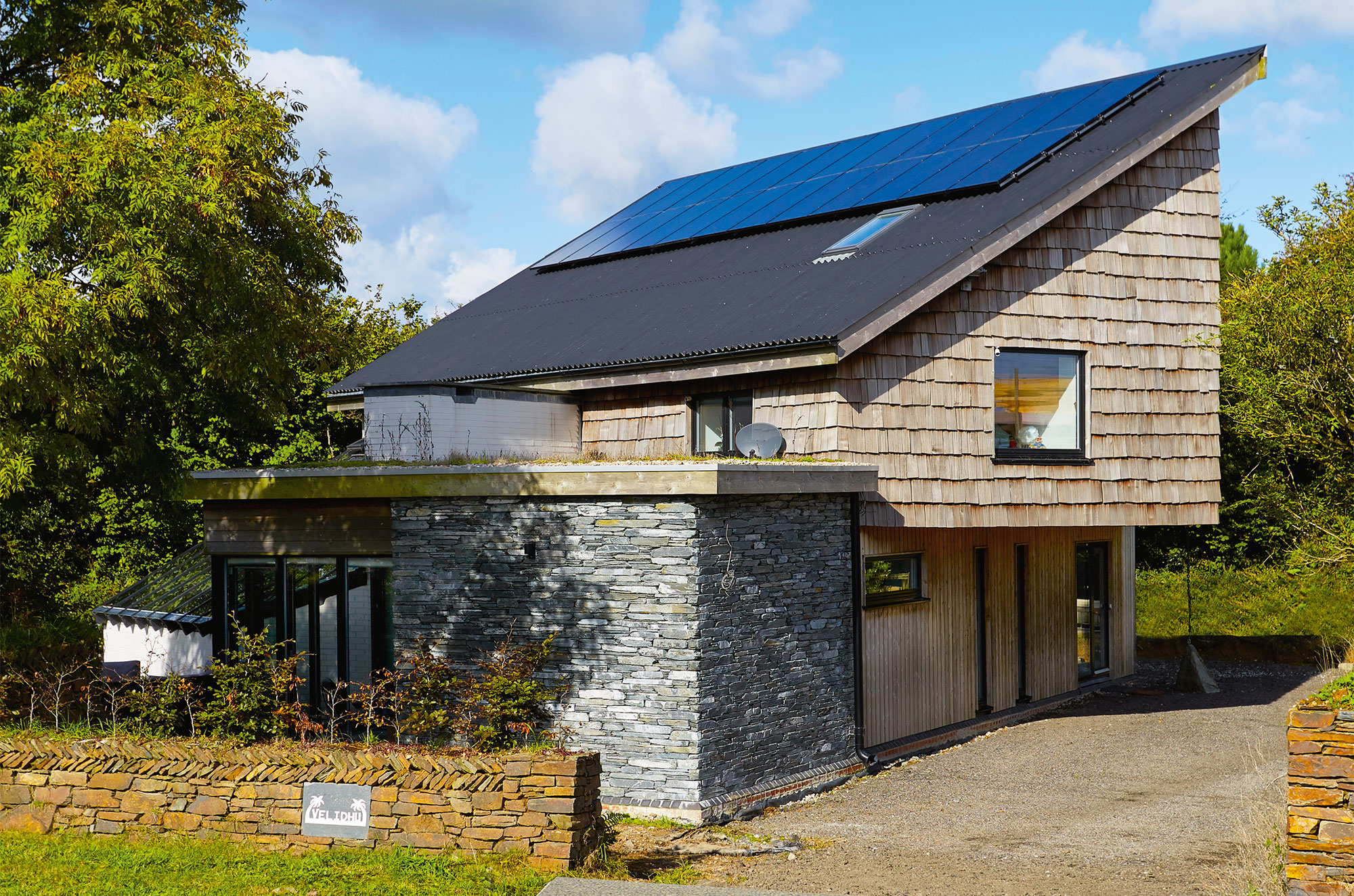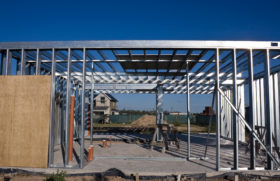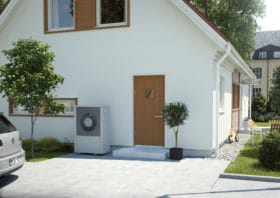
Early Bird Offer! Free tickets to meet independent experts at this summer's Build It Live
Save £24 - Book Now!
Early Bird Offer! Free tickets to meet independent experts at this summer's Build It Live
Save £24 - Book Now!Most of us are familiar with the idea that the easiest way to keep a house warm in winter is to add more insulation to the roof walls and floor. But there are more subtle interactions between the fabric of the building and temperature changes, both during the day and as the seasons change, that need to be considered when planning a project.
The thermal mass of a building describes how fast it absorbs heat from its surroundings and how long it takes to emit it afterwards. If this rate is controlled and accounted for in the design of a house, it will make it more comfortable to occupy and reduce the energy needed for heating.
It can also be used to keep rooms cooler in summer by absorbing warmth in the daytime and releasing it back into the living environment at night.
One way to visualise how thermal mass works is to think of it as a battery, storing heat and releasing it later on. If this phenomenon is integrated into your energy use strategy, it will help the building stay cool in summer and keep it warm in winter, making it a more pleasant place to live.
This approach can lower fuel bills by as much as 10%.
Traditional house builders often worked with materials with a high thermal capacity – particularly stone, brick and cob (otherwise known as mud). This resulted in homes that
had a natural ability to regulate their internal temperature.
In temperate climates such as the UK, historically the problem was how to stay warm in winter. The thermal mass of masonry fireplaces, chimneys and walls collected heat from the daytime burning of wood and coal, radiating it out and reducing the drop in temperature at night.

This stunning project by Arco2 Architecture features a masonry-built solarium to capture and store passive solar gains, with the rest of the house built in super-insulated timber frame. Photo: Paul Ryan-Goff
In recent times, global warming has resulted in the UK experiencing more uncomfortably hot days. As a result, air conditioning is becoming common in our homes, ironically adding more carbon into the atmosphere and in turn accelerating climate change.
Designers of modern houses can use thermal mass effects to regulate internal temperatures, naturally reducing overheating and potentially eliminating the need for a cooling system such as aircon. To get the most benefit, the temperature fluctuation between day and night should be at least 5°C – so this approach is worth exploiting in the UK, where the difference is 10°C.
For instance, a house made from dense materials such as brick or stone can be orientated so that there is plenty of glazing facing towards the south, to collect solar energy and store it within the structure. There should be a large overhang above the glass to shade rooms from the high angle summer sun but allow it to penetrate when it is lower on the horizon during the winter.
With conventional heating systems, such as a gas boiler and radiators, the cooled thermal mass of the building will need to be topped up in the morning before the overall temperature of the rooms starts to rise significantly. At night, when the heating turns off, the interiors will
cool slowly as the structure gradually releases its stored warmth.
This time lag as the temperature fluctuates can be a benefit or a disadvantage, depending on the lifestyle of the occupants of the building. This is best illustrated by looking at a couple of examples of how a home might be used in winter.
A young professional couple with no children will rise early in the morning, probably spend an hour or so in the house, then leave for work. The house will then remain empty with little need for heating until the couple return in the evening. They are likely to have active social lives, perhaps leaving for a night out shortly after arriving home and sometimes not getting back until late.
Learn more: Can Smart Heating Save You Money?
This professional pair will need a fast response from the heating system, with room temperature being reached quickly when they walk in the door and dropping when they are out. Typically, they may only need to switch the heating on two or three times a day for relatively short periods.
A high thermal mass may not suit this couple because it would take a long time to heat up and to cool down the house, whereas a low thermal mass would allow the building to respond quickly and avoid it running when they are out. A well-insulated thermally lightweight construction, such as timber frame property, would therefore suit them well.
Factors that Effect Thermal Store Design
|
By contrast, a retired couple may be in and around the house a lot more, coming and going on short trips several times during the day. In their case having a heating cycle that can respond quickly is of less benefit because the boiler would have to switch on and off frequently, reducing its efficiency and shortening its useful life. This household would benefit from a high thermal mass building, heated continuously during the day, because this would smooth out temperature fluctuations and place less demand on their boiler.
Many heavyweight building materials – such as concrete, sandstone, rammed earth, brick and blockwork – make good thermal stores because they are dense, but poor conductors of heat. The opposite is true of metals such as steel which, despite its weight, warms and cools very quickly.
Learn more: How to Insulate External Walls
As well as the actual materials used to store heat, the role of the insulation layer is vital. Conventional wisdom says the best place for insulation is on the outside of the mass: a masonry cavity wall with its blockwork inner leaf, for instance, or a solid wall enveloped in external insulation and render. A concrete floor will benefit in a similar way if the insulation layer is underneath it.
Insulated concrete formwork (ICF) walling also provides a good thermal store, since it consists of mass concrete encapsulated in a thick layer of insulation. The concrete core absorbs and stores heat, acting as a buffer. In combination with the surrounding insulation, this reduces temperature fluctuations – although it is slightly less effective overall than exposing a blockwork wall internally.
In the UK, the change in temperature over a typical 24-hour period is such that, in products like brick and concrete, most of the heat is stored in the first 50mm below the surface. This diminishes quickly to virtually negligible levels beyond 100mm. Hence walls built with lightweight insulating materials like straw bales can be given the capacity to store heat by being lined with a layer of lime or clay plaster up to 75mm thick.
If a material is a good thermal store, it can delay the heating and cooling of the inside of the house by about six hours compared to the changes in temperature outside. So to be most effective, the surface area of such materials is more important than their thickness. Covering them up with insulating products such as plasterboard or carpets should be avoided; instead, give preference to wet plaster and floor tiles.
Timber frame buildings generally do not have a high thermal mass.
Instead, they achieve good energy efficiency through a combination of excellent levels of factory-installed insulation and the fact that they’re extremely well sealed – enabling use of a mechanical ventilation and heat recovery (MVHR) system. All of this helps to reduce heat loss. A good example of the method in action would be a super energy efficient Passivhaus dwelling.

With cavity walling, the internal leaf’s thermal mass is available as part of the energy strategy – especially when combined with a wet plaster finish
Most timber frame structures will have some element of heavyweight building materials incorporated, most commonly seen in the form of concrete ground floors. By leaving that thermal mass available (ie with tiled floors), a timber frame house could make an ideal heat sink.
Thermally lightweight buildings can also be provided with extra capacity to store heat by using phase change materials (PCMs). When a material changes from a solid to a liquid, it absorbs a large amount of heat – and when it solidifies again it expels this energy, warming its surroundings. This transformation is called a phase change. The most well-known example is water, which can freeze, thaw and turn into steam.
PCMs are available for house construction. They’re designed to change from solid to liquid at justthe right temperatures to provide beneficial thermal mass, and are generally based on products such as palm oil, paraffin wax and rapeseed oil.
They can be incorporated into sheets of plasterboard, floor screeds and the like, and installed in timber frame houses to offer some of the thermal mass found in buildings made from more heavyweight materials.
Main Image: Paul Ryan-Goff

